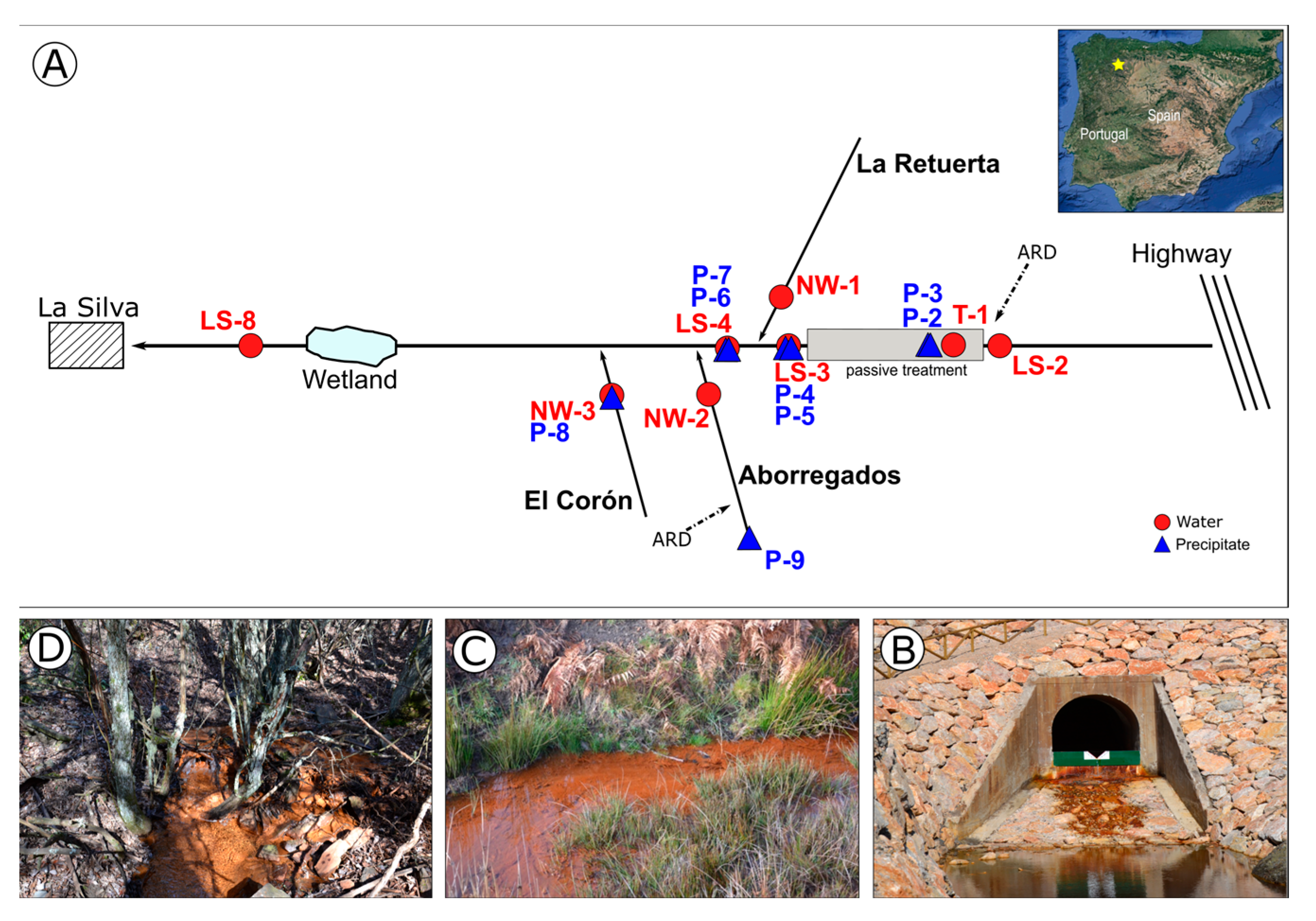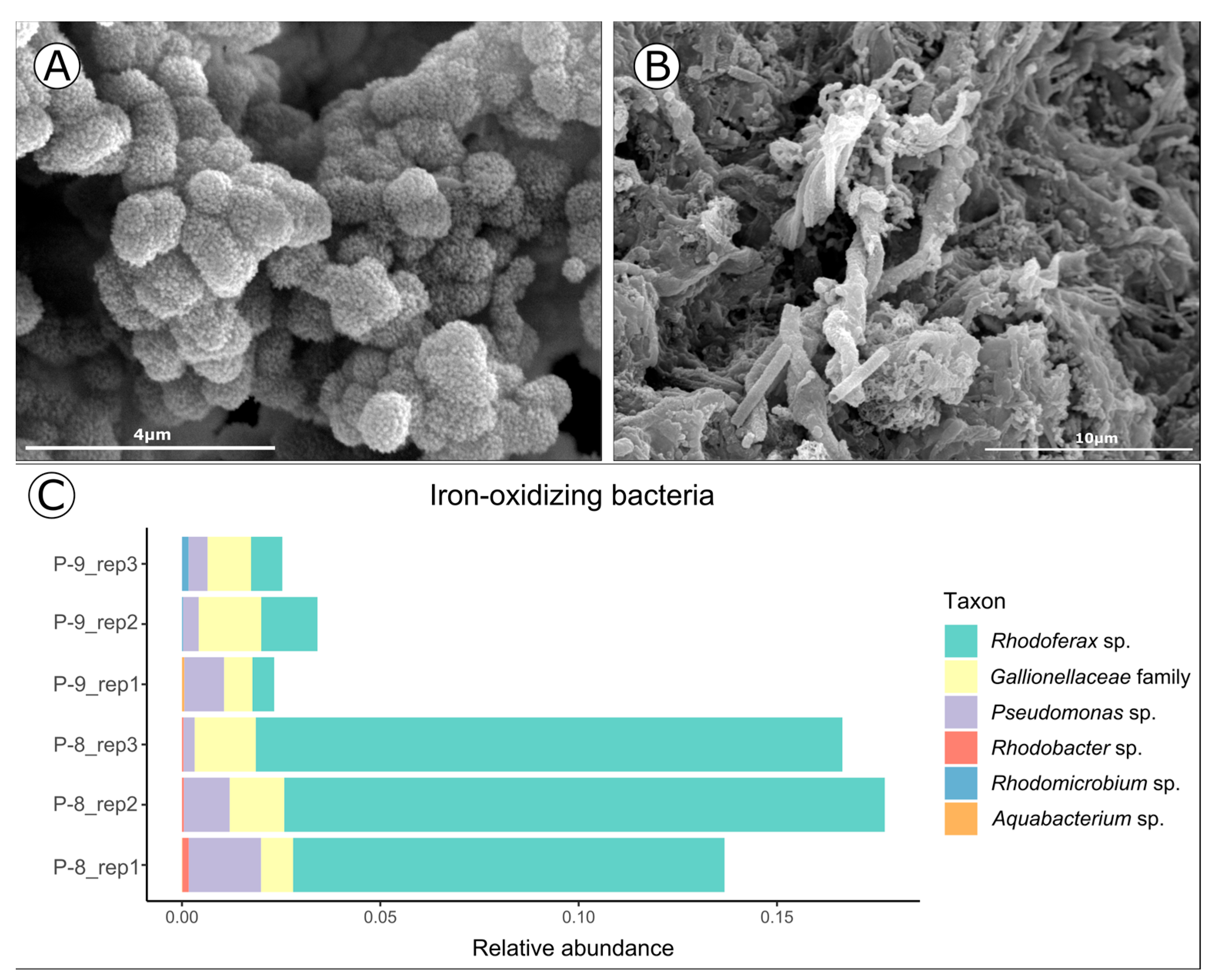Immobilization of Rare Earth Elements and Yttrium (REY) by Iron (Bio)Precipitation in Acid Sulfate Waters from El Bierzo (Spain) †
Abstract
:1. Introduction
2. Materials and Methods
2.1. Sampling Area and Geochemical Analysis
2.2. Rare Earth Elements and Yttrium (REY) Measurements
2.3. Identification and Characterization of Precipitates
2.4. Environmental Bacterial 16S Metabarcoding
3. Results and Discussion
3.1. High Concentrations of Rare Earth Elements and Yttrium (REY) in Stream Water
3.2. Iron (Bio)Precipitates and REY Immobilization
4. Conclusions
Author Contributions
Funding
Institutional Review Board Statement
Informed Consent Statement
Data Availability Statement
Acknowledgments
Conflicts of Interest
References
- Ferguson, K.D.; Morin, K.A. The Prediction of Acid Rock Drainage—Lessons from the Database. In Proceedings of the Second International Conference on the Abatement of Acidic Drainage, Montreal, QC, Canada, 16–18 September 1991. [Google Scholar]
- Santofimia, E.; González, F.J.; Rincón-Tomás, B.; López-Pamo, E.; Marino, E.; Reyes, J.; Bellido, E. The mobility of thorium, uranium and rare earth elements from Mid Ordovician black shales to acid waters and its removal by goethite and schwertmannite. Chemosphere 2022, 307, 135907. [Google Scholar] [CrossRef] [PubMed]
- Ayora, C.; Macías, F.; Torres, E.; Lozano, A.; Carrero, S.; Nieto, J.M.; Pérez-López, R.; Fernández-Martínez, A.; Castillo-Michel, H. Recovery of rare earth elements and yttrium from passive-remediation systems of acid mine drainage. Environ. Sci. Technol. 2016, 50, 8255–8262. [Google Scholar] [CrossRef] [PubMed]
- Mastalerz, M.; Drobniak, A.; Eble, C.; Ames, P.; McLaughlin, P. Rare earth elements and yttrium in Pennsylvanian coals and shales in the eastern part of the Illinois Basin. Int. J. Coal Geol. 2020, 231, 103620. [Google Scholar] [CrossRef]
- Ferris, F.G.; Tazaki, K.; Fyfe, W.S. Iron oxides in acid mine drainage environments and their association with bacteria. Chem. Geol. 1989, 74, 321–330. [Google Scholar] [CrossRef]
- Kim, J.; Kim, S.; Tazaki, K. Mineralogical characterization of microbial ferrihydrite and schwertmannite, and non-biogenic Al-sulfate precipitates from acid mine drainage in the Donghae mine area, Korea. Env. Geol. 2002, 42, 19–31. [Google Scholar] [CrossRef]
- Kawano, M.; Tomita, K. Geochemical modeling of bacterially induced mineralization of schwertmannite and jarosite in sulfuric acid spring water. Am. Mineral. 2001, 86, 1156–1165. [Google Scholar] [CrossRef]
- Santofimia, E.; López-Pamo, E. Performance of an open limestone channel for treating a stream affected by acid rock drainage (León, Spain). Environ. Sci. Pollut. Res. 2016, 23, 14502–14517. [Google Scholar] [CrossRef]
- Bolyen, E.; Rideout, J.R.; Dillon, M.R.; Bokulich, N.A.; Abnet, C.C.; Al-Ghalith, G.A.; Alexander, H.; Alm, E.J.; Arumugam, M.; Asnicar, F.; et al. Reproducible, interactive, scalable and extensible microbiome data science using QIIME 2. Nat. Biotechnol. 2019, 37, 852–857. [Google Scholar] [CrossRef] [PubMed]
- Chakhmouradian, A.R.; Wall, F. Rare Earth Elements: Minerals, Mines, Magnets (and More). Elements 2012, 8, 333–340. [Google Scholar] [CrossRef]
- Charalampides, G.; Vatalis, K.I.; Apostoplos, B.; Ploutarch-Nikolas, B. Rare Earth Elements: Industrial Applications and Economic Dependency of Europe. Procedia Econ. Financ. 2015, 24, 126–135. [Google Scholar] [CrossRef]
- Moss, R.L.; Tzimas, E.; Kara, H.; Willis, P.; Kooroshy, J. Critical Metals in Strategic Energy Technologies; European Commission: Luxembourg, 2011. [Google Scholar] [CrossRef]
- Verplanck, P.L.; Nordstrom, D.K.; Taylor, H.E. Overview of rare earth element investigations in acidwaters of U. S. Geological Survey abandoned minewatersheds. In U.S. Geological Survey Toxic Substances Hydrology Program—Proceedings of the Technical Meeting, Charleston, South Carolina, 8–12 March 1999; Morganwalp, D.W., Buxton, H.T., Eds.; Water-Resources Investigations Report 99–4018A; U.S. Geological Survey: West Trenton, NJ, USA, 1999; Volume 99, pp. 83–92. [Google Scholar]
- Zhao, F.; Cong, Z.; Sun, H.; Ren, D. The geochemistry of rare earth elements (REE) in acid mine drainage from the Sitai coal mine, Shanxi Province. North China Int. J. Coal Geol. 2007, 70, 184–192. [Google Scholar] [CrossRef]
- Hallbeck, L.; Pedersen, K. The Family Gallionellaceae. In The Prokaryotes; Rosenberg, E., DeLong, E.F., Lory, S., Stackebrandt, E., Thompson, F., Eds.; Springer: Berlin/Heidelberg, Germany, 2008. [Google Scholar]
- Kato, S.; Ohkuma, M. A single bacterium capable of oxidation and reduction of iron at circumneutral pH. Microbiol. Spectr. 2021, 9, e0016121. [Google Scholar] [CrossRef] [PubMed]


| Sample | Y | La | Ce | Pr | Nd | Sm | Eu | Gd | Tb | Dy | Ho | Er | Tm | Yb | Lu | REY | |
|---|---|---|---|---|---|---|---|---|---|---|---|---|---|---|---|---|---|
| Water | LS-2 | 38.07 | 44.7 | 81.16 | 9.09 | 34.5 | 6.89 | 1.43 | 8.12 | 1.21 | 6.86 | 1.32 | 3.51 | 0.46 | 3.07 | 0.49 | 241 |
| T-1 | 749 | 166 | 865 | 86.7 | 415 | 113 | 23.9 | 143 | 25.7 | 158 | 29.8 | 79.9 | 11.4 | 75.9 | 11.7 | 2954 | |
| LS-3 | 1047 | 233 | 1191 | 119.4 | 571 | 157 | 33.1 | 197 | 35 | 218 | 40.8 | 109 | 15.5 | 103 | 16 | 4086 | |
| LS-4 | 316 | 88 | 399 | 40.2 | 187 | 50.7 | 10.6 | 61.5 | 10.9 | 67.2 | 12.6 | 33.5 | 4.74 | 31.5 | 4.83 | 1318 | |
| LS-8 | 181 | 139 | 523 | 41.4 | 174 | 39.4 | 7.7 | 41.9 | 6.72 | 39 | 7.17 | 18.7 | 2.65 | 17.4 | 2.76 | 1242 | |
| NW-1 | 1.07 | 15 | 1.98 | 0.21 | 0.99 | 0.23 | 0.04 | 0.23 | 0.03 | 0.21 | 0.04 | 0.12 | 0.01 | 0.12 | 0.02 | 20 | |
| NW-2 | 119 | 323 | 1114 | 77.6 | 302 | 57.2 | 9.87 | 45.7 | 5.76 | 28.4 | 4.8 | 12.1 | 1.61 | 10.8 | 1.61 | 2123 | |
| NW-3 | 0.32 | 0.28 | 0.48 | 0.07 | 0.3 | 0.06 | 0.01 | 0.06 | 0.01 | 0.04 | 0.01 | 0.02 | 0 | 0.02 | 0 | 2 | |
| Precipitates | P-2 | 8.81 | 1.92 | 14.5 | 2.43 | 13.5 | 4.22 | 0.85 | 4.8 | 0.66 | 3.53 | 0.54 | 1.16 | 0.15 | 0.85 | 0.11 | 58 |
| P-3 | 6.17 | 2.19 | 12.8 | 1.93 | 11.2 | 3.47 | 0.69 | 3.61 | 0.5 | 2.42 | 0.42 | 0.89 | 0.11 | 0.61 | 0.08 | 57 | |
| P-4 | 5.97 | 1.96 | 11.2 | 1.87 | 10.5 | 3.28 | 0.67 | 3.69 | 0.5 | 2.5 | 0.36 | 0.8 | 0.09 | 0.51 | 0.07 | 44 | |
| P-5 | 9.05 | 2.72 | 13.6 | 2.06 | 12.1 | 4.39 | 0.88 | 5.06 | 0.69 | 3.42 | 0.56 | 1.23 | 0.14 | 0.75 | 0.09 | 57 | |
| P-6 | 15.54 | 7.1 | 39.3 | 4.91 | 25.4 | 7.13 | 1.42 | 6.83 | 1.06 | 5.85 | 1.04 | 2.6 | 0.4 | 2.66 | 0.4 | 122 | |
| P-7 | 4.66 | 0.98 | 8.97 | 1.69 | 9.9 | 3.17 | 0.66 | 3.32 | 0.43 | 2.24 | 0.33 | 0.76 | 0.1 | 0.65 | 0.08 | 38 | |
| P-9 | 5.44 | 10 | 48.8 | 2.01 | 8.13 | 1.7 | 0.84 | 1.6 | 0.17 | 1.01 | 0.21 | 0.57 | 0.09 | 0.63 | 0.1 | 81 |
Disclaimer/Publisher’s Note: The statements, opinions and data contained in all publications are solely those of the individual author(s) and contributor(s) and not of MDPI and/or the editor(s). MDPI and/or the editor(s) disclaim responsibility for any injury to people or property resulting from any ideas, methods, instructions or products referred to in the content. |
© 2023 by the authors. Licensee MDPI, Basel, Switzerland. This article is an open access article distributed under the terms and conditions of the Creative Commons Attribution (CC BY) license (https://creativecommons.org/licenses/by/4.0/).
Share and Cite
Rincón-Tomás, B.; González, F.J.; López-Pamo, E.; Santofimia, E. Immobilization of Rare Earth Elements and Yttrium (REY) by Iron (Bio)Precipitation in Acid Sulfate Waters from El Bierzo (Spain). Mater. Proc. 2023, 15, 47. https://doi.org/10.3390/materproc2023015047
Rincón-Tomás B, González FJ, López-Pamo E, Santofimia E. Immobilization of Rare Earth Elements and Yttrium (REY) by Iron (Bio)Precipitation in Acid Sulfate Waters from El Bierzo (Spain). Materials Proceedings. 2023; 15(1):47. https://doi.org/10.3390/materproc2023015047
Chicago/Turabian StyleRincón-Tomás, Blanca, Francisco Javier González, Enrique López-Pamo, and Esther Santofimia. 2023. "Immobilization of Rare Earth Elements and Yttrium (REY) by Iron (Bio)Precipitation in Acid Sulfate Waters from El Bierzo (Spain)" Materials Proceedings 15, no. 1: 47. https://doi.org/10.3390/materproc2023015047
APA StyleRincón-Tomás, B., González, F. J., López-Pamo, E., & Santofimia, E. (2023). Immobilization of Rare Earth Elements and Yttrium (REY) by Iron (Bio)Precipitation in Acid Sulfate Waters from El Bierzo (Spain). Materials Proceedings, 15(1), 47. https://doi.org/10.3390/materproc2023015047








